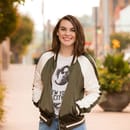If you’re an English major, you read a lot of books (or you sit in classes and listen to people talk about the books you haven’t read). I love my major, and so I always do my best to read every assigned text in order to make the most of my time in college. This decision pays off as I inevitably read and dissect great books every semester.
The thing about reading great books, though, is that you want everybody else to read them too! So I decided to rank 16 of the books I read this semester (according to my taste because truly these are all good books, all of them…I’m not even lying), so you can get a little taste of my sweet, sweet English major life.
Last fall semester, I took two literature classes, one creative writing class, one film class, and one class about science and technology. Altogether, my semester included 24 books (not including articles, short-stories, and poetry). But I decided to spare you the time by excluding scripts and textbooks, because neither of those are particularly fun to read. With that said, this list only includes books from my two literature classes: Young Adult Literature and American Fiction: Realism and Naturalism. The texts from these classes are vastly different, which proved ranking them a challenge.
One bonus is that these classes are taught by two of my favorite professors, Dr. Heather Braun and Dr. Patrick Chura. Feel free to read their CV in your spare time, although I don’t know why you would.
Before you read through the list, I’ll tell you a secret. One of these books I did not read. Can you guess which?
- “The Marrow of Tradition” by C.W. Chesnutt (1901)
-
Hear me out. This short novel can be hard to follow in the beginning because of the dialect writing and the elaborate web of characters, but read it all the way through and I promise you won’t be disappointed. Here’s what you need to know: It takes place in 1889, and portrays a fictional account of the very real Wilmington massacre from various black and white American points of view.
When I read it, I kept thinking about Charlottesville, the immigrants at the U.S. border, and the growing list of black Americans gunned down by police officers. There are people who think we might be living in a post-racial society. All you have to do is watch the news to know that this is an absurd judgement. Believe it or not, a great portion of white America thought they were free of the race problem because they ended slavery. It was a false judgement, and so is the decision to ignore issues of mass-incarceration because we had a black president. This novel is a reminder of just how deep the spirit of American racism runs, and just how ugly it is. According to Chesnutt, the marrow of the American tradition is that racism.
I never read a novel quite like this before, and when I finished it (THE ENDING!!!), I got that rare feeling a book gives you. It buckled my knees and hollowed my chest, and so I urge you to read and feel the same.
- “The Grapes of Wrath” by John Steinbeck (1939)
-
Believe it or not, I had never read “The Grapes of Wrath.” Now that I have, I can’t disagree with anyone who wants to argue that this is the greatest work of American literature. My only qualm was that I had to read it so quickly for class. This is a book that you’re meant to drink in, slow. It would be an excellent summer read if you like depressing reads that absolutely eviscerate American capitalism. You know, casual stuff.
If you’re unfamiliar with the plot, it is a fictional telling of the dust bowl migration that led hundreds of thousands of Americans from the Midwest and Great Plains into California and into poverty. The novel follows an Oklahoma family called the Joads during their travels, but it isn’t exactly “Little Miss Sunshine.” I highly recommend this book because, like “The Marrow of Tradition, it deals with still-relevant themes and ideas. It has stood the test of time, but I’m not sure that’s something to brag about. (Also, THE ENDING!!!)
- “The Perks of Being a Wallflower” by Stephen Chbosky (1999)
-
I have read this book at least a dozen times. It might be my favorite ever! I often refer to it as my bible before I found the real Bible (I hope that’s not blasphemy). But because I’m biased, I thought it might be wrong to place it at #1.
It follows a teen boy named Charlie through his freshman year of highschool. Every time I read it, I read something new. Chbosky’s epistolary format makes the novel an intimate interaction between reader and narrator. It deals with themes of identity, sexualilty, mental health, friendship, and much more. Whoever you are, and however old you are, this novel will offer you something.
Also, I MET STEPHEN CHBOSKY LASt SEMESTER! Did I cry? No. My eyes were wet.
- “The Catcher in the Rye” by J.D. Salinger (1951)
-
I first read this book in highschool, and I enjoyed it then too. There are a lot of people who read it and hate its protagonist Holden Caulfield. I mean, truly despise him. That was the general feeling in my Y/A Literature class. There are also a lot of people who dislike the book because “nothing happens.” When it was released, critics disliked it because they found it “showoffy.”
Okay. I realize I’m not really selling it right now. I promise you it’s not all bad. Instead, it’s all very controversial. It’s one of the most enduring American texts of all time! Sure, it’s been linked to several high-profile murders, but that doesn’t mean the book is monstrous.
Okay, I’m still not helping.
Here’s what I think: I think it is a deep dive into the psyche of a young boy who has been neglected and disturbed by life. I know people like Holden, and I empathize with them deeply. I don’t think readers need to like Holden, so long as they can understand him.
And I think it’s incredibly good writing. That’s my take.
- “O Pioneers!” by Willa Cather (1913)
-
This book has all the things I like. Environmentalism, feminism, subversion of gender norms, homoerotic subtext, gun politics, tragedy, love, and a kooky guy named Ivar. It may have been published in 1913, but it reads like it was written in 2019.
This work of historical fiction follows a Swedish-American family living in the Great Plains while everybody else was jumping ship for city-life. In addition to its stinging social commentaries, it’s also just wildly entertaining. When I was reading it, I kept thinking, “Oh man, they should make this into a movie!”
Well, they did. I haven’t seen it, but it stars Jessica Lange and I know how the people feel about Jessica Lange.
- “Children of Blood and Bone” by Tomi Adeyemi (2018)
-
This is the most recently published novel on this list, and it’s also the only fantasy. It’s also a trilogy, for all my series lovers out there. I have not yet read the second book, “Children of Virtue and Vengeance,” which was released on December 3rd of 2019 but if it’s anything like the first, I expect it’s a success.
Grounded in black activism and inspired by West-African mythology and Yoruba culture, there is more to this book than magic. It follows a few young characters and heroine Zélie Adebola on a quest to restore magic to the land of Orïsha. Despite the fact that this book is huge, it is a pretty quick read due to its action-packed sequences and quippy dialogue. I would compare it to “Harry Potter,” but this novel is really in a lane of its own.
I think you should read this book if you want to know what the kids (and adults) like these days.
- “The Rise of Silas Lapham” by William Dean Howells (1885)
-
Fellow Her Campus Akron contributor Kendall Miller and I both enjoyed this book, but I sometimes wonder if we were the only ones among our classmates who did. It follows the nouveau-riche Lapham family as they attempt to integrate into high society. May I just say, Penelope Lapham is a kindred spirit…I audibly laughed while reading this nearly 135 year old book and I don’t know if that says more about me or William Dean Howells! Read it, and then you can tell me.
On top of that, the novel’s ideas about class are well-stated. It might be a slower read, but it’s a rollercoaster ride nevertheless.
- “Iola Leroy” or “Shadows Uplifted” by Frances Ellen Watkins Harper (1892)
-
If you’re familiar with Frances Ellen Watkins Harper, it’s probably for her poetry. Two of her popular poems include “The Slave Mother” and “Eliza Harris.” Harper wrote this fictional novel to use in classrooms as a tool for teaching black history, so as you can imagine, it deals with heavy issues. In a time where black history is still overlooked and re-written, a novel like this is beneficial to all who read it. Covering subjects such as passing, miscegenation, temperance, reconstruction and more, every chapter sparks necessary debate. It is a relatively easy read if you take your time, and will leave keep you thinking even after you close the book.
- “The Absolutely True Diary of a Part-Time Indian” by Sherman Alexie (2007)
-
This is where the list that starts to get really tricky.
This novel is structured like a balloon that grew so big it popped in your face. It follows a Native American teenager called Junior as he copes with death, poverty, growing up, and moving schools. A historically overlooked voice in America, the story of a young Native American boy is an important one. It is told well, through humour and illustrations.
Yet, in light of sexual harassment allegations against the author, the novel poses age-old questions about separating the art from the artist. If you choose to read this novel, my advice is to buy it used or get it from your local library to avoid giving your money to someone who exhibits harmful behavior toward women.
- “The Outsiders” by S.E. Hinton (1967)
-
A teenage class war, what more could a girl want?
All jokes aside, this novel is a classic for a reason. The teenagers feel real because they were written by a teenager (S.E. Hinton was 15 at the time!!). Maybe you aren’t a rich Soc or a working-class Greaser, but you will identify with the characters in this novel. Throughout my Y/A Literature class, we constantly referred back to this novel’s assertion that “It’s rough all over,” that the human experience is challenging no matter who you are. This novel sets the tone for decades of Y/A, and seems to say that growing up can’t be a selfish experience. The brotherhood represented in this novel can also work to inform positive representations of masculinity and kinship. This novel endures because it so intimately felt, even if (every once in a while) you can tell a 15 year old wrote it.
P.S. If you’re up in arms about reading it, check out the 1983 film. Sodapop is played by Rob Lowe, all young and blue-eyed. Also, the Karate Kid is in it! Just don’t get to attached…
- “Eleanor and Park” by Rainbow Rowell (2012)
-
This novel is just about as cheesy as you can get. It’s the story of a first love as told by two perspectives—you guessed it, Eleanor and Park. I may still be young, and I may never have been in love, but this book reminds me of what it’s like to be young and in love.
The novel has a lot to say about identity, and how relationships shape our identity. In the face of adversity, Eleanor and Park become more of who they are because they meet one another. It’s a sweet read that casts a big girl and an asian man as romantic leads. It may seem like nothing, but this novel is filling a gap that desperately needs to be filled in Y/A lit. It is important for young people to see themselves in the books they read, especially ones embrace the fact that everyone can be loved.
- “Wonder” by R.J. Palacio (2012)
-
Okay, fine! I confess… I must have tried to read “Wonder” four times before I finally read it front to back for the class. Previously, I had just gotten so bored. Still, this book isn’t exactly my taste, but it has a positive message that is perfect for middle schoolers or younger children with guidance. “Wonder” is about a young boy named Auggie who has a facial deformity and the people around him. More simply, it’s a novel about empathy. Told from multiple perspectives, the novel shows you what it’s like to walk in someone else’s shoes. It’s an excellent, expertly written novel for a young audience.
- “Summer” by Edith Wharton (1917)
-
A fun fact about Edith Wharton is that she was formerly Edith Jones of the Jones family, who were rich socialites over whom the public obsessed. Ever heard of “keeping up with the Joneses?” The phrase likely emerged thanks to this writer’s family. So you can thank them for the catchy Kardashian series title.
Although I am not particularly concerned with Edith Wharton’s wealth or her family’s success, I am a fan. I previously read her most famous work, “The House of Mirth,” and after reading “Summer,” I’m still a fan! Wharton’s novels may be a far cry from what we might consider “feminist” novels, but her work unapologetically reminds its readers that women are complex, significant people constrained by the social structures of their time. This romance/coming-of-age novel follows Charity Royall, a young small-town adoptee, as she muses on class, love, family, and her own sexual awakening. Her character is relentlessly annoying as well as just entertaining.
I desperately wanted to put this higher on the list, but something prevented me. At the risk of spoiling something, what do you think happens to a dreaming, spitfire woman at the turn of the century?
- “Daisy Miller” by Henry James (1878)
-
I first read Henry James in highschool, and I was not a fan. As I slugged on through “The Turn of the Screw,” I constantly thought, “Man, who taught this guy to write sentences?” With complicated sentences packed with phrases, I found it hard to engage in his actual storytelling.
“Daisy Miller” made me think, “Well, maybe I am a James fan.” This little novel redeemed my opinion of Henry James and introduced the world to Daisy Miller, a radical, nouveau riche American woman who just won’t listen to the social rules of her day.
- “Sister Carrie” by Theodore Dreiser (1900)
-
This novel follows a woman named Carrie who moves to the big city, where she pursues her dreams in a place hellbent on crushing them. Not to mention, she’s a woman. The intersection of class and gender is a big force in the novel, and one which makes Carrie such an interesting character.
It is hard to say much more about this without spoiling the ending, because the ending was my favorite part. The rest of the book, however, nearly bored me to death. It’s not that it was lacking action or plot, but Dresier’s prose is utterly exhausting. It is skilled writing, sure, but today’s editors would have hammered his nearly 600 page novel down to 400. I’m not sure it is wise to measure a 1900 novel to modern standards, but I can’t help but wonder if I would have enjoyed it more with a newer voice.
- “We Were Liars” by E. Lockhart (2014)
-
It is hard to write about this book because it is a psychological thriller that relies on ambiguity and shock to tell its story, and (because I’m a kind person) I refuse to spoil it for you. Still, here is my controversial opinion about this critically acclaimed novel:
Protagonists are allowed to be unlikable, but I think Cadence Sincair is tragically unlikable. I found it hard to root for her. Of course, maybe that was the point… Still, I found the narration boring and rather annoying, so my favorite parts of the book were the clever allegorical fairy tales which E.L. Lockhart interspersed throughout. It has some sweeping romantic lines that John Green himself would struggle to pull off, and I found the characters unnecessarily underdeveloped. All of this amounts to a great idea that wasn’t executed poorly, but also wasn’t executed expertly.
I don’t want to dissuade you from reading this because (clearly) I’m in the minority opinion on this one. Read, and decide for yourself!


